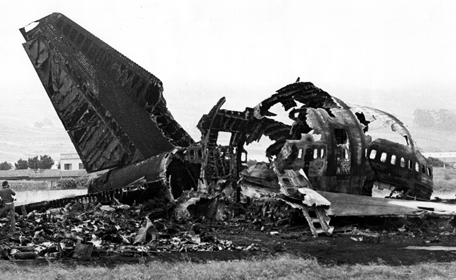On March 27, 1977, two 747 airliners collided on a runway in the Canary Island of Tenerife, killing 583 people, more than any plane crash in history.
Deadly Plane Crash Occurs on Tenerife
Pan Am Flight 1736 from Los Angeles, via New York, and KLM Flight 4805 from Amsterdam were scheduled to land at Las Palmas, the capital of the archipelago located off the coast of northwest Africa, on the afternoon of March 27, 1977. However, Canary independence group Fuerzas Armadas Guanches set off a bomb at the Los Palmas airport, forcing incoming flights to land at the much smaller Los Rodeos Airport in Tenerife, the largest island of the Canaries.
The two 747s waited at Los Rodeos along with several other large planes until Las Palmas was reopened. The airport’s taxiways were overcrowded, forcing airport officials to use the lone runway as both a runway and a taxiway.
After several hours, Los Palmas was reopened, and the Pan Am and KLM planes prepared to take off. KLM 4805 went first, taxiing up the runway and turning around to take off. Pan Am 1736, meanwhile, was instructed to taxi halfway down the runway and park at a taxiway; however, pilot Victor Grubbs missed the intended taxiway and continued down the runway toward the next one.
Due to a misunderstanding with flight control, KLM pilot Jacob Veldhuyzen van Zanten decided to take off before receiving proper clearance. In a heavy fog, he was unable to see that Pan Am 1736 was still turning left into the taxiway.
Sources in this Story
- Salon: Ask the pilot
- PBS: NOVA: The Deadliest Plane Crash
- Time: ‘…What’s he doing? He’ll kill us all!’
Seeing the KLM barreling down the runway at his plane, Grubbs exclaimed, “There he is! Look at him! Goddam, that son of a bitch is coming!” He tried to race his plane off the runway as co-pilot Robert Bragg repeatedly shouted, “Get off!” Van Zanten made a last-second attempt to turn his plane upward, but it clipped the top of the Pan Am.
“Roaring at full power, the KLM’s hot engines (2000° F.) and massive landing gear crunched through the Pan Am’s fuselage with such impact and explosive fire that aluminum and steel parts of both planes were vaporized,” wrote Time. “The KLM’s giant engine airlets sucked fragments of the Pan Am jet into its innards before crumpling into a molten mass 1,500 ft. past the point of impact.”
All 248 people aboard the KLM flight were killed, as were 335 of the 396 people aboard the Pan Am. With 583 fatalities, the Tenerife crash is the deadliest plane crash in history.
Project-Tenerife.com offers a variety of articles, reports, speeches, photos and videos documenting and remembering the Tenerife disaster.
Related Events
Changes to Air Safety After Tenerife
After Tenerife, changes were made to communication protocols between pilots and flight control to avoid the kind of miscommunication that led to the KLM plane taking off without clearance.
Since 1977, technological developments have also improved aircraft safety. Pilot Patrick Smith writes that most airports now have radar that allow controllers to see where planes are on the runways at all times, while some planes have satellite technology that enables them to see surrounding traffic. Lighting has also improved, which improves visibility and lessens the chance that a pilot would miss a turn as Grubbs did.
PBS’ NOVA lists 10 crashes since 1977 that have contributed to major advances in safety.











